As the calendar turns to November, our thoughts naturally turn to baseball… What!? 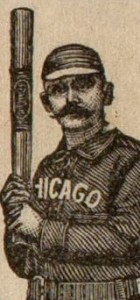 Really? Yes, this year it took until November first to crown a World Series champion. Each year it seems, the games are on later and later (in the day and in the year). Can the casual fan sustain his interest over the long season? Apparently not. Game Three of this series had the second lowest television ratings in Series history, and according to a recent New York Times article, Game Four this past Sunday night marked the first time a World Series game lost to an N.F.L. game in prime time.
Really? Yes, this year it took until November first to crown a World Series champion. Each year it seems, the games are on later and later (in the day and in the year). Can the casual fan sustain his interest over the long season? Apparently not. Game Three of this series had the second lowest television ratings in Series history, and according to a recent New York Times article, Game Four this past Sunday night marked the first time a World Series game lost to an N.F.L. game in prime time.
Baseball is not the national craze it once was, dominating sports fandom when the major competition was pugilism and horse racing. Football, basketball, hockey and, [gulp], soccer now offer sports fans a panoply of choices. With the NFL, the NHL and the NBA seasons all underway, it is little wonder television is having some difficulty bringing viewers to baseball, even for the World Series. We are left to wonder if the poor ratings will tarnish the long love affair between advertisers and baseball.
From Dustin Pedroia selling tires to Mariano Rivera selling chalupas, from Ted Williams selling soft drinks, Joe DiMaggio selling cigarettes, and Babe Ruth selling, well, everything, advertisers have long used the image of popular baseball players and baseball teams to hock their wares. If you think it’s a 20th (or 21st) century phenomenon, think again. In the American Antiquarian Society’s collections there are many examples from the 19th century of advertisers associating themselves with baseball.
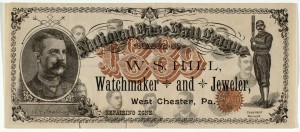
One nice example is a bank note advertisement from 1889. W.S. Hill, Watchmaker and Jeweler from West Chester, Pennsylvania issued a flyer, made to resemble currency, with an image of Albert Goodwill Spalding and a generic Chicago White Stocking player on the front and portraits of twelve members of the 1888 Chicago White Stockings on the reverse. The White Stockings, who would become the Cubs in 1903, did not win the National League pennant in 1888 (the first World Series was still 15 years away) and came in third in 1889 so we’re left to wonder why a Philadelphia area jeweler chose a team from Chicago in its advertising.
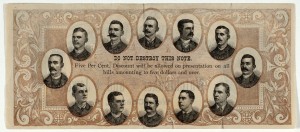
Spalding, a pitching standout for Boston and Chicago in the 1870s and by 1889 the president of the Chicago franchise, was very popular, though. He was a tireless promoter of the game (and the sporting goods company which still bears his name), bringing the champion Boston Red Stockings to England in 1874 (he would bring his White Stockings on a world tour later in 1889). Also on the White Stockings was future Hall-of-Famer Adrian Constantine Anson, known to teammates and fans as Cap. Anson played 27 seasons of major-league baseball, including 19 as a player-manager, and was the first member of the 3,000 hit club, but is now notorious for his refusal to play with African-American players then in the major-leagues. Anson’s face is prominently placed in the top center of W.S. Hill’s bank note advertisement, surrounded by his teammates.
Another popular place to advertise which continues to the present day is on a team’s schedule. The advertisement has lasting value, the theory goes, because the owner will want to refer to it throughout the season. Each view is another impression for the advertiser. AAS has several examples from the late 1800s, but perhaps the finest (and certainly the most bizarre) is from E. K. Brooks & Son, Boston. The piece, entitled “Judgment!” has pixies (or fairies or brownies) climbing over a baseball with the chief pixie barking out directions (alternatively, the pixie-in-chief could be an umpire making a call, hence the title). What precisely is being implied a fairy-covered ball is lost to history (although, no doubt, readers of this blog will have something to say on the topic).
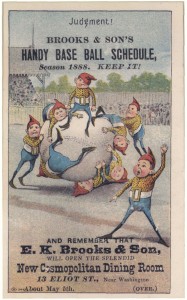

On the back of Brooks & Sons Handy Base Ball Schedule is the 1888 schedule of the Boston Beaneaters (now the Atlanta Braves, via Milwaukee). The “convenient table” shows when the local nine will be home and “abroad” and of course, “where you can get the Best MEA[sure] of VI[c]TUALS in Boston for a Little Money.”
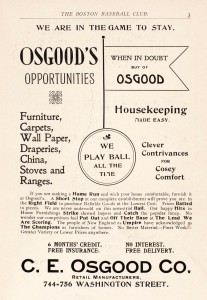
Baseball and advertising have a long, intertwined, and entertaining history. It would be great to push the history back further and find earlier examples of advertisements with a baseball theme. Just how early did it all start? Is the earliest piece at the American Antiquarian Society? I don’t know but it will be fun trying to find out.

Mr. Bouchard writes an interesting piece. Advertising has been around for years and I wonder what advertising ploys helped fill the Roman Colosseum.
The Vice President of Readex (whose American Broadsides and Ephemera product has digitized the Brooks & Sons trade card described in the post above) has a great comment on the question of whether the trade card has pixies, fairies, or brownies on the baseball.
Check it out!
http://pastispresent.wpengine.com/2009/news/welcome/#comment-3369
Would love to own the baseball currency used for this article!!